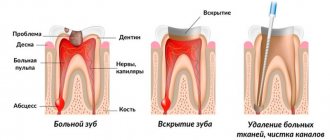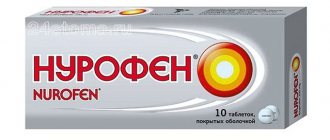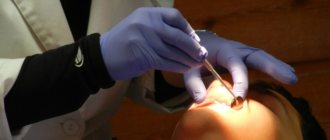How does a tooth hurt after filling?
Toothache after filling is considered a normal reaction if it is characterized by the following manifestations:
- the pain does not bring much discomfort and intensifies only when pressing on the treated tooth;
- the pain is mild, aching and without attacks;
- there is no swelling of the cheek, no increase in temperature and no deterioration in general well-being.
A distinctive feature of post-filling pain is a gradual decrease in discomfort.
What to do if your tooth hurts after installing a filling?
You should pay attention to the nature of the pain. If it is aching, tolerable, and is not associated with food intake, then the chances are high that everything will work out on its own.
You should worry if:
- The pain is throbbing, increases towards night, the sealed tooth with the nerve hurts - this indicates inflammation of the pulp.
- Unpleasant sensations appear only when biting or pressing on the filling - most likely, the filling technology is broken.
- There is a feeling that the tooth is sticking out, there is discomfort when chewing - the filling is too large.
- The mouth burns, the gums hurt, the mucous membrane turns red and swells - signs of an allergic reaction.
- The pain does not decrease, but may intensify. The gums swell, general malaise appears, and the temperature rises. These symptoms indicate that periodontitis is developing.
Why does pain occur after root canal filling?
Pain after filling occurs due to several reasons:
- poor quality treatment;
- incorrect installation of fillings with malocclusion;
- shrinkage of filling materials;
- overheating of tissues;
- breakage of a dental instrument;
- perforation of the walls of the dental canal;
- improper drying of the walls of the prepared cavity;
- incomplete pulp extraction;
- incorrect treatment of the tooth cavity;
- individual intolerance to filling materials.
Causes of pain under a filling
There are several reasons why a tooth under a filling may hurt:
- Incomplete pulp removal. This can happen if an x-ray was not taken before treating the tooth. A tooth may have its own structural features: thin winding canals, the presence of additional canals. Without radiography, it is impossible to carry out high-quality canal treatment. Remaining areas of pulp will certainly lead to pain.
- Burn of dental tissues. During tooth preparation, the dental bur heats up. If the dentist does not cool the tissue frequently, you can get burned.
- Incorrect technique for drying the prepared cavity. Violation of the technique leads to insufficient adhesion of the filling to the dental cavity. Bacteria penetrate inside and cause inflammation.
- Entry of a foreign body into the root canal. This could be a piece of a canal cleaning tool or particles of dentin (hard tooth tissue) formed during drilling.
- High filling. When a tooth comes into contact with an opposing tooth on the opposite jaw, pain occurs due to too much pressure.
These reasons apply to cases where a tooth that was filled very recently hurts.
Sometimes patients go to the dentist complaining of pain in teeth that were filled several months or years ago. Probable reasons for this:
- Secondary caries. It develops due to the penetration of bacteria under the old filling due to its shrinkage or mechanical damage. A hidden inflammatory process begins, affecting the nerve (if it has not been removed before and the filling was installed due to caries).
- Periodontitis. If the nerve has already been removed previously, then it is not the cause of the pain. It is possible that periodontitis has developed - inflammation of the periodontium (the connective tissue surrounding the tooth). Periodontitis occurs due to the penetration of bacteria into the periodontal ligaments or mechanical trauma to the tooth (bruise, blow, sharp biting).
In all the described cases, one cannot hope that the pain will go away on its own. If the inflammatory process has already begun, it will spread more and more. You can lose a tooth due to neglect of your health
How long does a tooth hurt after filling?
The duration of pain depends on the intensity of the intervention in the tooth tissue. The deeper the manipulation, the longer the pain will persist.
After cured caries, discomfort may be present for 4-5 days. After filling the dental canals, the pain persists for 2-4 weeks, with a gradual decrease in discomfort.
After periodontitis, the feeling of pulsation is felt for about a month. Depulped dental units can cause discomfort for 1-2 months.
If your tooth hurts when you bite
Most often, it is not possible to catch caries in the stain stage, when it has affected only the top layer of dentin. Because once caries appears, it develops rapidly, quickly penetrating into the dentin of the tooth. And the deeper the caries penetrates into the dentin, the more serious intervention is required during treatment.
If a tooth hurts when biting after a filling, this may be a short-term reaction to the deep preparation. In this case, the pain should go away within two weeks.
In the image of the tooth, you can see that the dentin is directly adjacent to the pulp. The pulp is the very place where pain originates, even with the slightest impact. Therefore, pain when biting can occur when the filling is not polished sufficiently. In this case, when you bite, with another tooth you put pressure on the filling that is too high in the bite, and the filling, in turn, physically affects the pulp, and then the tooth hurts under the filling.
Many people think that they can wait a few days and the filling will wear itself out. This is not true; a filling that is too high in bite size injures the surrounding tooth tissue, which may lead to the need to re-treat the tooth, and possibly even to removal. And why endure this unexpected sharp pain if you can ask your dentist to further polish the filling? This is an absolutely painless and quick procedure.
Also, pain in the tooth after filling when biting may indicate inflammation of the surrounding tooth tissue. If you do not feel the filling, but the pain becomes more frequent and stronger, then you need to contact your doctor to determine the exact cause.
If the pain bothers you for more than two weeks or becomes unbearable, you should immediately contact your doctor.
It may be necessary to place a filling on the tooth using a different material to reinstall it. The dentist may decide to place medication and a temporary filling.
When should you see a dentist?
Immediately after dental treatment, it is important to be attentive to your condition.
You should immediately consult a doctor at the LEVI-DENT clinic if the following symptoms appear:
- acute fever with increased body temperature;
- swelling and hyperemia of the gums near the treated tooth;
- pronounced swelling of the face;
- pain when biting food;
- putrid breath;
- swelling and distension in the oral cavity;
- infiltration on the gum with the formation of an abscess.
The presence of the above signs indicates the development of infectious tissue damage, which can lead to complications.
First aid for inflammation
It is better to use any medications to combat pathological symptoms after consulting a doctor, since all medications in this group have different compositions and a list of contraindications. At home, you can use various rinses as first aid before going to the dental clinic. They are not recommended for use for more than two days, since the absence of qualified assistance for a long period of time can worsen the patient’s condition and lead to the progression of the pathology.
Calendula decoction with salt
Calendula is one of the most famous medicinal plants. Calendula flowers (marigolds) have a disinfectant, antimicrobial and healing effect, so a decoction of this plant helps to quickly cope with inflammation and speed up the healing of soft tissues. If you add salt to the decoction, you can improve the condition of the gums during purulent inflammation, since any salt perfectly draws out pus and ensures the outflow of exudate.
To prepare a medicine to treat inflammation, you must:
- Pour 100 g of calendula flowers into 700 ml of boiling water and put on low heat;
- cook for 15-20 minutes;
- add a tablespoon of salt and cook for another 5 minutes;
- leave for an hour and strain.
You should rinse your mouth with this decoction 3 to 10 times a day (depending on the degree of inflammation). Symptoms usually become less noticeable on the second day of use.
Bread crumb infusion
If you don’t have medicinal plants at hand, you can use a very simple but effective recipe and prepare an infusion from bread pulp. You can use any type of bread made from rye or peeled flour, as they contain a large amount of minerals and vitamins that have a positive effect on the condition and health of the gums.
Preparing the infusion is very simple:
- break one piece of bread (approximately 50-70 g) into small pieces and place in a shallow container;
- pour 300 ml of boiling water and add half a spoon of salt;
- leave for 5-7 minutes and cool.
You should rinse your mouth with this infusion 3-5 times a day. The product perfectly helps with any inflammatory processes, pain after treatment and tooth extraction, as well as at the initial stage of purulent-infectious processes.
How to treat a tooth after root canal filling?
Post-filling pain after acute and chronic periodontitis is treated according to the following algorithm:
- dental examination;
- unfilling of root canals;
- instrumental and medicinal treatment of root canals;
- applying a therapeutic pad;
- installation of a temporary dental filling;
- re-treatment of the tooth cavity;
- installation of a permanent dental filling.
If pulpitis occurs, it will be necessary to open the pulp chamber and carry out manipulations aimed at killing the nerve .
You can make an appointment with a dentist in Lyubertsy on the website or by phone.
How to get rid of gum pain?
Unpleasant sensations in the gums in the first hours after dental treatment are normal. A good doctor will always warn the patient about such things after a dental procedure.
However, a distinction must be made between some discomfort and pain that is difficult to bear. Discomfort is characterized by unpleasant sensations, tingling, and sometimes slight pain in the treatment area during the first two days. The opposite is a state of unbearable pain, the inability to eat, rolling and throbbing pain. In this case, the patient cannot function normally: work or fall asleep.
Causes of pain after dental treatment
- Individual patient reaction to an anesthetic injection. Gums and soft tissues react differently to the action of the injected drug;
- Rejection of the installed filling. Soft tissues “do not accept” the filling installed by the doctor, signaling this with pain;
How to relieve gum pain at home
In any case, the patient is unlikely to be able to function normally, since the pain tends to increase: it becomes more frequent and more difficult for the person to bear. Therefore, it is better to visit the doctor again as soon as possible. If for some reason it is impossible to do this, then try to reduce the pain yourself.
- Try not to eat foods at high or excessively low temperatures. This will only aggravate the situation, since in the first time after treatment the gums are sensitive to external irritants;
- Brush your teeth only with a cool brush. There is a misconception that a warm toothbrush helps reduce gum pain. In fact, this will only increase the sensitivity of already inflamed tissues;
- Do not apply mechanical force to the gums. This applies to both the pressure applied when brushing your teeth and simple picking in your mouth out of curiosity. It is human nature to touch those places that hurt, so make sure that soft tissues are not touched by hands or other objects;
- Under no circumstances apply traditional painkillers or disinfectants to the gums - peppers, garlic, and so on.
- Rinse your mouth with a salt solution, a decoction of sage or chamomile. When rinsing, try to focus on the affected area. At the same time, do not forget that you should not abuse this procedure - rinse no more than three times a day;
- Crush one tablet of analgin and aspirin. Mix the resulting powder, pour it onto a cotton swab (or a cotton swab) and gently apply it to the inflamed area without pressing;
- If the pain is mild, then prepare the following solution: add 0.02 furatsilin to a full glass of water. Mix thoroughly and caress the inflamed area 3 times a day for 5 minutes.
Remember that these recommendations are intended to alleviate the patient’s condition and gain time to visit the doctor.
Therefore, even if you feel the pain easing, do not rush to refuse a visit to the clinic. After a short period of calm and cessation of home treatments, the pain may intensify again, so it is wiser to deal with the root cause of the inflammation in the doctor's office. You can find out more about the features of gum treatment among our services. MAKE AN APPOINTMENT
Gum pain in a child
Teeth growth
. In young children, unpleasant and painful sensations can be caused by teething. In this case, children constantly gnaw and bite objects, making it clear that they are “uneasy” in their mouth. If the cause of concern is teething, then make sure that the toys and special objects the child bites are treated with antiseptics to prevent infection. The best option would be to buy a special rubber “biting ring” for your child and treat it with an antiseptic.
Infection
. If a child experiences severe pain, he either cries or lets his parents know that he has pain “in the mouth.” This may be the cause of infection from constant bites of various objects. At home, you can temporarily use Nurofen or Viburkol. However, the best solution is to visit a doctor.
Tablets against pain in the gums:
- Analgin
. A common cheap pain reliever that is found in almost every first aid kit. Efficiency is average. - Nise.
This is a serious drug that specializes in muscle pain and post-traumatic consequences. - Ketanov
. The most effective drug against toothache. - Dexalgin
. A fast and long-lasting drug. - Baralgin
. An effective pain reliever. The effectiveness is average, since severe pain requires taking two tablets at a time. The patient is not recommended to exceed the norm of 6 tablets per day. - Nurofen.
In addition to relieving pain, it also directly affects the soft tissue of the gums. - Paracetamol. Used against pain, inflammation and fever. A cheap product that is in every first aid kit.
Why does the pain get worse at night?
Surely a person has noticed throughout his life that pain in the mouth (gums, teeth, throat) begins to worsen at night. More often a person notices this in two ways:
- Before sleep, there is an increase in pain.
- A man wakes up in the middle of the night in pain.
The peculiarity of such phenomena is that in the morning the unpleasant sensations subside. So what is the reason? The mystery lies in the nature of the process - inflammation. This process in the human body is regulated by the adrenal glands - glands near the left and right kidneys. In the evening and at night, the adrenal glands do not work, so the pain is felt more strongly. When morning comes, they are active again, which improves the person’s condition.
How to keep your gums healthy
As has already become clear, one of the causes of pain is the incorrect insertion of an artificial tooth or its rejection by soft tissues. But the fact is that it is wiser, in principle, not to bring the tooth to the point of removal or artificial replacement.
Firstly
, having natural healthy teeth is better than wearing artificial implants.
Secondly
, this will save the patient from possible pain and complications after the installation procedure, although it does not exclude the chance of pain in his own teeth.
Third
, if a patient receives an implant, this increases by half the chance that he will have another artificial tooth installed in the near future. The fact is that if the doctor finds one unhealthy tooth that needs to be removed, then there is a high probability that another similar one is “ripening” in the mouth, because this indicates the general level of oral hygiene of the patient.
Therefore, maintain oral hygiene: brush your teeth at least twice a day, select a suitable brush and toothpaste with the help of dentists, use rinses and dental floss. Also, remember to visit your dentist at least twice a year. Good luck!
We recommend you read it
What is the difference between periodontal disease and periodontitis?
How and how to relieve toothache at home
Pulpitis
How to help yourself at home
All home remedies that are recommended for use if a tooth aches under a filling reduce the symptoms, but do not eliminate the cause. These measures are temporary and are applied until you see a doctor. The only exception is natural pain after a filling has been placed.
Pharmacy painkillers will help you relax and sleep. Rinsing with salt or soda relieves irritation. Infusions of herbs, calendula, chamomile, and sage have a disinfectant and anti-inflammatory effect.
Modern dentistry has a negative attitude towards such traditional medicine as a hot compress. This can increase inflammation, cause bleeding and a purulent process.











